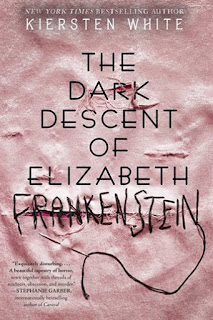ANCILLARY RETELLING
A popular strategy used
in reimagining stories is to focus on one of the original tale's
secondary characters, making them the hero of their own adventure.
Those characters exist in the world of the original, or canonical,
fiction for which they were created.
Those adventures can be
extra canonical. For example having Mrs. Hudson, the landlady of Sherlock Holmes, solving her own mysteries exploits the Sherlockian
fictional space without interfering with the canonical stories.
Others use a more involved
approach using the parallel tale of this secondary character as a
tool for a retelling of the original story. For example 'The Dark
Descent of Elizabeth Frankenstein' by Kiersten White follows the
beats of the originalMary Shelley 'Frankenstein or the Modern Prometeus' (the
1831 edition where Elizabeth is an unrelated orphan). In the original
story Elizabeth Lavenza, adopted into the Frankenstein family and
destined to marry Victor the family heir acts passive and supportive.
So does the Elizabeth from 'The Dark Descent...'. But in this version
the passive behaviour is an act, as Elizabeth is always hyper
sensitive that the protection of the Frankenstein family could be
withdrawn if she does not help them control their psychopath son.
This premise creates a double parallel narrative that is both an original text and a reference to another text. It can be read as a self contained YA fantasy
but there is another layer of reading in tracking down the canonical
parts woven in.
Elizabeth's original
role as confidant and moral support from the original Shelly text is expanded
into a resourceful and active character with a secret life. This
secrecy justifies her actions not being mentioned in Victor's version
of the story as he is unaware of how far Elizabeth will go to keep
his confidence in her. Elizabeth weaves figuratively and literally in
and out of the story of Victor and his creature. She secretly travels
to Victor's whereabouts when he goes incommunicado for long periods
of time (as he does in the original) and gradually pieces together
what he did. The self-centered hubris of the original Victor experimenting without thinking of the consequences is
replaced by the inhuman single mindedness of someone without empathy. The original story beats
are carefully followed but now altered (for example Elizabeth is
the one who destroys the monster's bride) gradually moving toward a conclusion that is different from the source material while still paying it homage.
The interactions between Elizabeth, now the main character, and other originally secondary characters fleshes them out, gives them back stories and weaves them more actively in the plot. The greatest change is in the original main characters. Victor is not the hero of this story but the challenge that Elizabeth has to overcome. The creature is an invisible presence who only show himself late in the story, a mystery that Elizabeth gradually solves.
Among pastiches, ancillary retelling is less common than other reimaginings. It is relatively easy to give a secondary character their own adventures, or to have them show a different point of view to re-narrate an original tale. By making an ancillary character a hero the narrative shifts into another dimension where the focus of who or what is important is changed.
The interactions between Elizabeth, now the main character, and other originally secondary characters fleshes them out, gives them back stories and weaves them more actively in the plot. The greatest change is in the original main characters. Victor is not the hero of this story but the challenge that Elizabeth has to overcome. The creature is an invisible presence who only show himself late in the story, a mystery that Elizabeth gradually solves.
Among pastiches, ancillary retelling is less common than other reimaginings. It is relatively easy to give a secondary character their own adventures, or to have them show a different point of view to re-narrate an original tale. By making an ancillary character a hero the narrative shifts into another dimension where the focus of who or what is important is changed.
